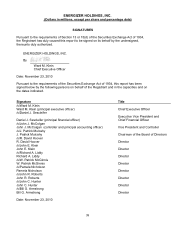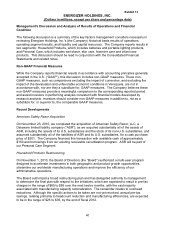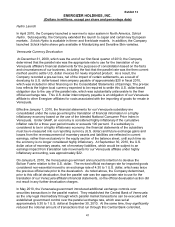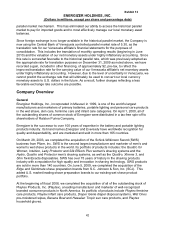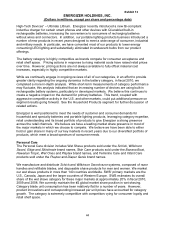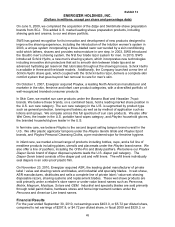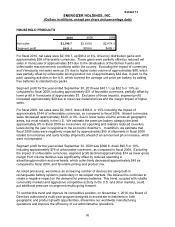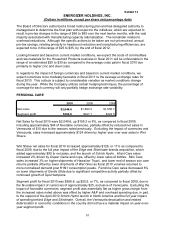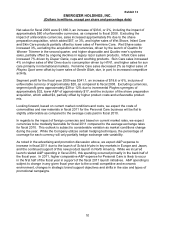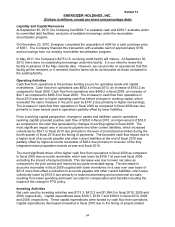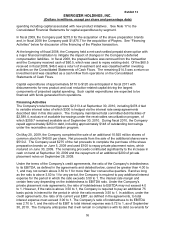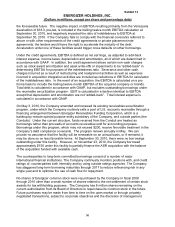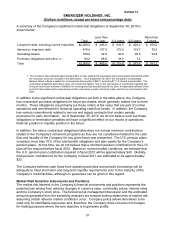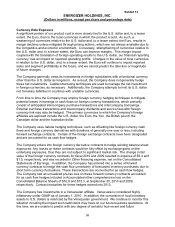Energizer 2010 Annual Report Download - page 59
Download and view the complete annual report
Please find page 59 of the 2010 Energizer annual report below. You can navigate through the pages in the report by either clicking on the pages listed below, or by using the keyword search tool below to find specific information within the annual report.
Exhibit 13
ENERGIZER HOLDINGS, INC.
(Dollars in millions, except per share and percentage data)
49
For Fiscal 2008:
• A tax benefit of $11.0 was recorded in fiscal 2008 associated with the write-up and
subsequent sale of inventory acquired in the Playtex acquisition, and
• Adjustments were recorded to revise previously recorded tax provisions to reflect
refinement of estimates of tax attributes to amounts in filed returns, settlement of tax
audits and other tax adjustments. This adjustment increased the tax provision by $1.1
in fiscal 2008.
The Company's effective tax rate is highly sensitive to country mix, from which earnings or
losses are derived. Declines in earnings in lower tax rate countries, earnings increases in
higher tax rate countries, repatriation of foreign earnings or operating losses in the future could
increase future tax rates. Additionally, adjustments to prior year tax provision estimates could
increase or decrease future tax provisions.
Segment Results
Operations for the Company are managed via two segments - Household Products (battery
and portable lighting products) and Personal Care (wet shave, skin, feminine and infant care).
Segment performance is evaluated based on segment operating profit, exclusive of general
corporate expenses, share-based compensation costs, costs associated with most
restructuring, integration or business realignment activities, including the prior year VERO, RIF
and change in PTO policy, and amortization of intangible assets. Financial items, such as
interest income and expense, are managed on a global basis at the corporate level. This
structure is the basis for the Company’s reportable operating segment information presented in
Note 17 to the Consolidated Financial Statements.
For fiscal 2010, the Company recorded a pre-tax loss of $18.3 due primarily to the recent
devaluation of our Venezuela affiliate’s U.S. dollar based intercompany payable. This impact,
which is included in other financing on the Consolidated Statements of Earnings, is not
considered in evaluating segment performance. However, normal operating results in
Venezuela, such as sales, gross margin and spending, have been negatively impacted by
translating at less favorable exchange rates and by the impact of unfavorable economic
conditions in the country. These operating results remain part of the reported segment totals.
The negative impacts of the Venezuela devaluation and the unfavorable economic impact on
operating results are discussed separately when considered relevant to understanding the
year-over-year comparatives.
The reduction in gross profit associated with the write-up and subsequent sale of the inventory
acquired in the Edge/Skintimate acquisition in fiscal 2009, which was $3.7, and the Playtex
acquisition in fiscal 2008, which was $27.5, as well as the related acquisition integration costs
in all periods presented are not reflected in the Personal Care segment, but rather presented
below segment profit, as they are non-recurring items directly associated with the acquisitions.
Such presentation reflects management’s view on how it evaluates segment performance.
The Company’s operating model includes a combination of stand-alone and combined
business functions between Household Products and Personal Care, varying by country and
region of the world. Shared functions include product warehousing and distribution, various
transaction processing functions, and, in some countries, a combined sales force and
management. Such allocations do not represent the costs of such services if performed on a
stand-alone basis. The Company applies a fully allocated cost basis, in which shared business
functions are allocated between the businesses.


